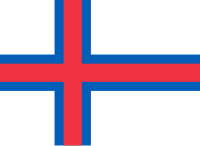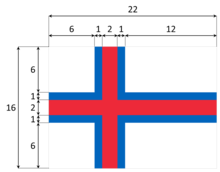Flag of the Faroe Islands
| Merkið | |
|---|---|
 |
|
| Vexillological symbol : |
|
| Aspect ratio: | 8:11 |
| Officially accepted: | 5th June 1959 |
The flag of the Faroe Islands , in Faroese Merkið (in German : sign or banner ), was officially introduced in its current form on July 5, 1959. In a 2004 survey, 17% of Faroese households said they had both the flag and a flagpole so they could flag publicly.
Description and meaning

The flag of the Faroe Islands is a white Scandinavian cross flag with an azure-rimmed fire-red cross. The structure is taken from the flag of Norway .
The Faroese Flag Act of July 17, 1959 provides:
- § 1. Føroya flag he hvítt krossmerki. Krossurin er fagurreyður (PMS 032) og azurblárandaður (PMS 300). Reyði liturin er 1/8 av flaggsins breidd and bláu rendurnar 1/2 av reyða litinum. Teir hvítu teigarnir eru ferhyrndir. Teir næst stongini javnliðaðir, men hinir tvær ferðir so langir. Munurin millum breidd og longd flaggsins er sum 8-11.
Translation:
- § 1. The flag of the Faroe Islands is a white cross banner. The cross is fiery red ( PMS 032) and rimmed with azure blue (PMS 300). The red color area is 1/8 the width of the flag, and the blue border is half as wide as the red area. Their white areas are rectangular. They are equilateral towards the flagpole and twice as long towards the other side. The width to length ratio of the flag is 8 to 11.
Accordingly, with a division of 16 × 22, the flag has a red cross in width 2 with azure blue borders in width 1, and 6 units in white towards the mast, and 12 units in white on the flight section.
According to the creators of the flag, white is supposed to be reminiscent of the foam of the sea and the pure, bright sky of the Faroe Islands, while the old Faroese colors blue and red as a cross reminds of the ties with other Nordic nations.
history
The ram has always been the heraldic animal of the "Sheep Islands". When the first unofficial flags were used with the national revival movement in the 19th century , a white ram on a blue background with a wide red border was used. Later, the Faroese national bird , the oystercatcher ( Tjaldur ), was used instead of the ram . Then in 1915 Iceland developed its own cross flag (after the stockfish and later the falcon were used there) based on the Scandinavian model. Probably under this influence from the neighboring country the desire arose to use a cross flag as well to underline the Nordic affiliation of the nation.
The Faroese cross flag was designed in Copenhagen in June 1919 by Faroese students Jens Olivur Lisberg from Fámjin , Janus Øssursson from Tórshavn and Pauli Dahl from Vágur , sewn by Ninna Jacobsen (older sister of Liffa Gregoriussen ) and the first on June 22nd of the same year Hoisted in the Faroe Islands - in Lisberg's birthplace Fámjin. This historical copy has been hanging in the church in Fámjin since 1955.
At Ólavsøka 1930 there was a scandal when the Dannebrog was overtaken and the Merkið was hoisted in front of the Løgtings building in the middle of the ceremonial opening of parliament. From 1931 onwards it was common on the islands, but it was only recognized by the local parliament, not by the Danish authorities.
During the British occupation of the Faroe Islands in World War II , the flag was officially introduced on April 25, 1940, after it was already used on April 11, 1940 to distinguish it from occupied Denmark . This was important for the British in order to be able to distinguish the Faroese ships from those of occupied Denmark . On land, however, the Dannebrog was still used. Since then, April 25 has been a non- working holiday in the Faroe Islands as flag day .
Since the Autonomy Act of March 23, 1948, it has been finally recognized as the flag of the Faroese nation . Guiding on land and at sea was permitted. On June 5, 1959, the hitherto darker navy blue was changed to the current shade. On December 29, 1998, the colors were precisely defined using the Pantone Matching System .
Formal regulations
The flag of the Faroe Islands can be used by anyone in the Faroe Islands and Denmark. In the Nordic Council , the flag of the Faroe Islands stands on an equal footing with that of the other Nordic countries. Flag Day has been April 25th since 1940.
Flag days
On the flag days, the flag of the Faroe Islands is to be raised by public institutions on the islands. They were last stipulated in the regulation of the state government of the Faroe Islands of April 23, 2003.
No flag days, but general holidays in the Faroe Islands are Maundy Thursday (Skírisdagur) and Prayer Day (Dýri biðidagur - the 4th Friday after Easter). Christmas Eve (Jólakvøld), Christmas Day , Easter Monday and Whit Monday are also not flag days, but non-working days with the corresponding flag day before / after.
| date | Faroese name | Occasion / meaning | Remarks |
|---|---|---|---|
| January 1st | Nýggjársdagur | New Year | Public holiday, New Year's Eve from 12 noon |
| February 6th | Samiskur flaggdagur | Flag day of Sápmi (Lapland) | |
| 8th of March | Altjóða kvinnudagur | International Women's Day | |
| March 12th | Graecarismessa | Arrival of the Tjaldur | |
| March 23 | Norðurlandadagur | Day of the north | |
| Langifríggjadagur | Good Friday | Half-mast , work-free | |
| Páskadagur | Easter Sunday | Public holiday, Easter Monday also non-working | |
| April 16 | Føðingardagur drotningarinnar | Queen birthday | |
| April 25 | Flaggdagur | Faroe Islands Flag Day | Public holiday, work-free from 12 noon |
| 1st of May | Altjóða arbeiðaradagur | International Working Class Day | |
| 17th of May | Tjóðardagur Noregs | National holiday of Norway | |
| Kristi Himmalsferðardagur | Ascension of Christ | Public holiday | |
| May 26 | Føðingardagur krúnprinsins | Crown Prince Birthday | |
| Hvítusunnudagur | Pentecost Sunday | Public holiday, Whit Monday also non-working | |
| June 5th | Grundlógardagur Danmarkar | Foundation day of Denmark | Public holiday, work-free from 12 noon |
| 6th of June | Tjóðardagur Svøríkis | National Day of Sweden | |
| June 9th | Tjóðardagur Álands | Åland National Day | |
| 17th of June | Tjóðardagur Íslands | National Day of Iceland | |
| June 21st | Tjóðardagur Grønlands | Greenland National Day | |
| June 24th | Jóansøka | St. John's Day | |
| July 28th | Ólavsøkuaftan | Ólavsøka evening | Public holiday, work-free from 12 noon |
| 29th of July | Ólavsøkudagur | Ólavsøka | National holiday, Løgtings opening |
| October 24th | Dagur Sameindu tjóða | United Nations Day | |
| November 1st | Minningardagur teirra sjólátnu | Remembrance day for those who stayed at sea | Half mast |
| 6th of December | Tjóðardagur of Finland | National Day of Finland | |
| 25 December | Jóladagur | Christmas | Public holiday, 24th and 26th also non-working |
One of the "Seven Faroese Wonders"
For Ólavsøka 2007, Faroese television Sjónvarp Føroya organized a nationwide competition on the “Seven Faroese Wonders”, in which viewers could make any suggestions about special buildings and other objects. A ranking of the eight winners (due to a tie in one case) has not been announced, but the first Faroe Islands flag in Fámjin Church is one of them. The others are the stalls of Kirkjubøur , the Magnus Cathedral , the Christianskirkjan in Klaksvík, the House of the North , Tinganes , the Norðoyatunnilin and the seat of the imperial ombudsman in the Faroe Islands (tie for the flag in Fámjin).
See also
Web links
- Faroe Islands . Flags of the World (English)
- Hans A. Djurhuus : Sjá tú blána . (Flag poem, 1920)
- Legal text (Danish)
- Legal text (English)
Individual evidence
- ↑ a b c d Smith, Neubecker: Coats of arms and flags of all nations . Munich 1981, ISBN 3-87045-183-1
- ^ Gallup Føroyar , accessed October 17, 2012 (Faroese)
- ↑ Føroyingar hava valt Sini undurverk . ( Memento of September 27, 2007 in the Internet Archive ) (“The Faroese have chosen their marvels”) portal.fo , July 28, 2007


